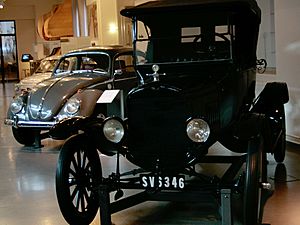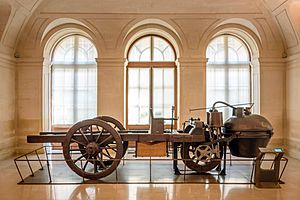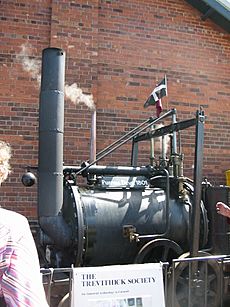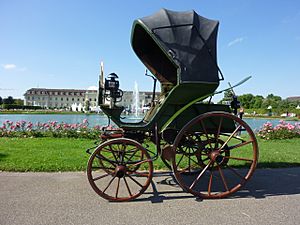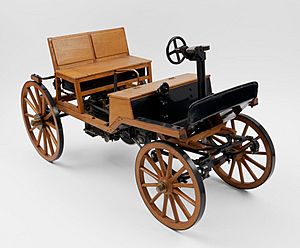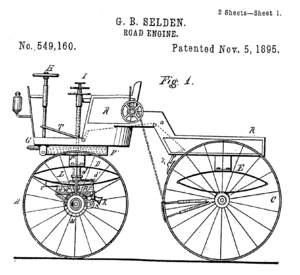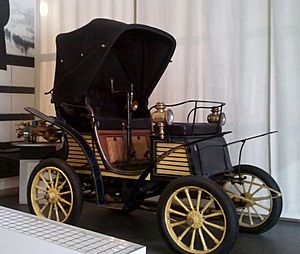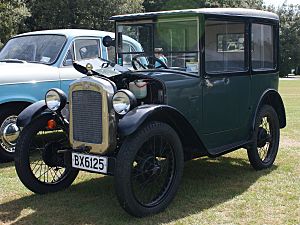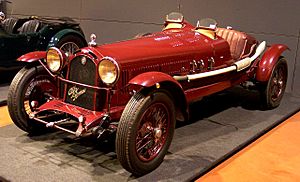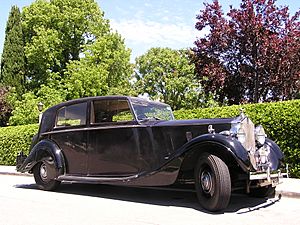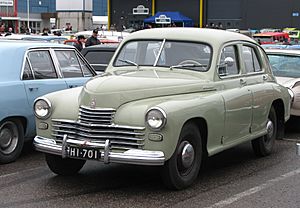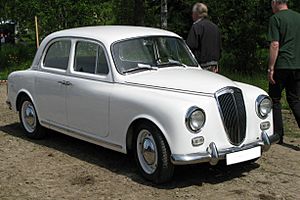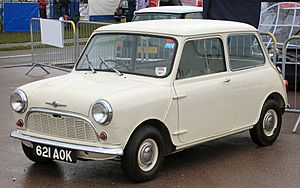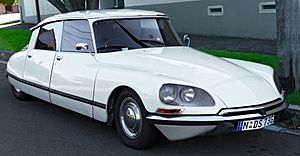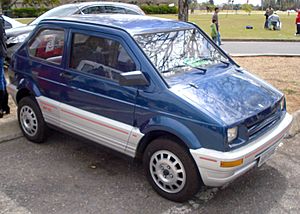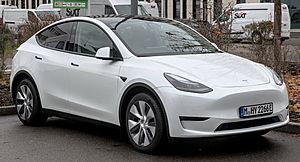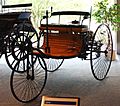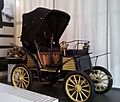History of the automobile facts for kids
Cars have a long and exciting history! It all started in 1672 with the first steam-powered vehicle. Then, in 1769, Nicolas-Joseph Cugnot built the first steam-powered car that could carry people. In the early 1800s, inventors tried new ideas like the de Rivaz engine, which was one of the first internal combustion engines, and early electric motors.
In 1826, Samuel Brown tested an early internal combustion engine that was used in factories. But the biggest change came in 1886. That's when Carl Benz created the first modern car powered by gasoline. It was practical and could be sold to many people. He even made several copies of it! Later, in 1890, Gottlieb Daimler and Wilhelm Maybach started their own car company. These companies eventually joined together to form Daimler-Benz in 1926, known for its famous Mercedes-Benz cars.
After 1886, many people started building "horseless carriages" in America and Europe. New ideas and inventions quickly made cars better. Ransom E. Olds started Oldsmobile in 1897. He was a pioneer in using the assembly line with interchangeable parts. This allowed him to make thousands of cars by 1903. In 1908, the Ford Motor Company changed car making even more. They sold the Ford Model T at a low price. By 1913, Ford used a moving assembly line. This cut the Model T's price by almost half, making it the first car many people could afford.
How Cars Get Power
Early car makers worked hard to find the best way to power their vehicles.
Steam-Powered Cars
Early Steam Vehicles (1600s-1700s)
Around 1672, Ferdinand Verbiest, a Jesuit in China, built a small steam-powered toy vehicle for the emperor. It couldn't carry a driver, but it might have been the first working steam vehicle.
Later, in the late 1700s, bigger steam vehicles were made to carry people and goods. Nicolas-Joseph Cugnot showed his "steam dray" (a type of wagon) in 1770 and 1771. His design wasn't practical. So, the focus shifted to Great Britain. By 1784, William Murdoch built a working model of a steam carriage. In 1801, Richard Trevithick drove a full-sized steam vehicle on roads in England.
Steam Cars in the 1800s
Many people tried to use steam-powered cars in the 1800s. New features like hand brakes and better steering were invented. Some steam vehicles were even used for mass transit (carrying many people). However, people started to dislike these large vehicles. Laws were passed, like the UK Locomotives Act 1865. This law said that a person had to walk in front of self-propelled vehicles on public roads, waving a red flag and blowing a horn. This rule almost stopped car development in the UK for a long time. Inventors then focused on railway locomotives instead. This law wasn't removed until 1896.
In 1867, Henry Seth Taylor, a Canadian jeweler, showed his four-wheeled "steam buggy." He started building it in 1865. In 1873, Frenchman Amédée Bollée built steam road vehicles to carry groups of passengers.
The first car for roads in the United States was a steam vehicle. Dr. J.W. Carhart invented it in 1871 in Wisconsin. This led to the first city-to-city car race in the US in 1878. The winning car from Oshkosh finished a 201-mile course in 33 hours and 27 minutes. It averaged about 6 miles per hour.
Steam Cars in the 1900s
Steam-powered cars were at their best in the early 1930s. They had better boilers and engines. But gasoline engines also got much better, becoming easier to use and more reliable. Also, new diesel engines started to replace steam for wagons. After 1931, no major steam cars were made.
Some people still wonder if steam cars will ever come back. In the 1950s, there was interest in steam-turbine cars powered by small nuclear reactors. But fears about nuclear technology stopped these ideas.
Electric Cars
Early Electric Cars (1800s)
In 1828, Ányos Jedlik from Hungary built a tiny model car powered by his new electric motor. In 1834, Thomas Davenport in Vermont put his DC electric motor into a small model car. In 1835, Professor Sibrandus Stratingh and his assistant in the Netherlands made a small electric car using batteries that couldn't be recharged. In 1838, Robert Davidson from Scotland built an electric train that went 4 miles per hour.
It's hard to say who made the very first electric car. Between 1832 and 1839, Robert Anderson of Scotland invented a simple electric carriage. In 1881, French inventor Gustave Trouvé showed a working three-wheeled electric car. In 1884, English inventor Thomas Parker built an electric car in London. He used his own special rechargeable batteries. But some people think the Flocken Elektrowagen from 1888 by Andreas Flocken was the first real electric car.
Electric Cars in the 1900s
Electric cars were popular in the late 1800s and early 1900s. Electricity was a favorite way to power cars. But then, gasoline engines got better, especially with the invention of the electric starter. Gasoline cars could go farther, refuel faster, and gasoline stations became common. Also, companies like Ford started making gasoline cars much cheaper than electric cars. This caused electric cars to almost disappear from the market by the 1930s.
Electric Cars Today (2000s)
Today, people are worried about how gasoline cars affect the environment. Gasoline prices are also higher. Battery technology has improved a lot. All these reasons have brought back interest in electric cars. They are seen as better for the environment and cheaper to run, even if they cost more to buy at first.
Internal Combustion Engines
Gas-Powered Engines
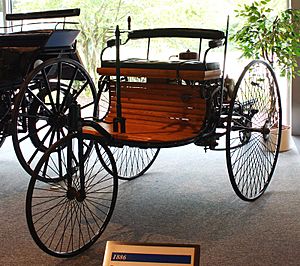
Early attempts at internal combustion engines struggled to find good fuels. So, some of the first engines used gas mixtures. In 1806, Swiss engineer François Isaac de Rivaz built an engine powered by a mix of hydrogen and oxygen. In 1826, Samuel Brown tested his hydrogen-fueled engine in a vehicle in London. In 1860, Etienne Lenoir's car, with a hydrogen-gas engine, drove about 9 km in three hours. A later version used coal gas.
Gasoline Engines
Nicolaus Otto and Eugen Langen built a working engine in 1867. Around 1870, in Austria, inventor Siegfried Marcus put a liquid-fueled engine on a simple cart. This made him the first person to move a vehicle using gasoline. This is known as "the first Marcus car." His second car, built in 1875, was the first gasoline-driven car. It is now in the Vienna Technical Museum. Marcus was honored as the inventor of the car during his life. However, his place in history was almost erased later on.
Carl Benz built his first car, the Benz Patent-Motorwagen, in 1885 in Germany. It is seen as the first modern car that was practical and could be sold to people. It was also the first car made in a series (many copies). Benz got a patent for his car in 1886. He started making cars in 1888 after his wife, Bertha Benz, proved the car could travel long distances. She drove over 80 km from Mannheim to Pforzheim and back.
Soon after, in 1889, Gottlieb Daimler and Wilhelm Maybach in Germany designed a vehicle specifically to be a car. They are also often given credit for inventing the first motorcycle in 1885.
In 1892, Frederick Bremer built the first four-wheeled gasoline car in the United Kingdom. In 1895, Frederick William Lanchester made another in England and also invented the disc brake. The first electric starter was put on an Arnold car between 1895 and 1898.
Eras of Car Invention
The Horseless Carriage Era (Veteran Era)
In America, George B. Selden filed for a patent on a car engine and its use in a four-wheeled car in 1879. His patent was granted in 1895. Selden allowed most major American carmakers to use his patent for a fee. However, the Ford Motor Company fought this patent in court and won. Henry Ford said the patent actually slowed down car development in the US.
The first cars were made by Carl Benz in 1888 in Germany. Others like Léon Bollée also built cars. By 1900, many cars were being made in France and the United States.
The first company made only to build cars was Panhard et Levassor in France. They also introduced the first four-cylinder engine. By the early 1900s, the car industry grew fast in Western Europe, especially in France.
In the US, many local mechanics experimented with car designs. Charles and Frank Duryea started the Duryea Motor Wagon Company in 1893. This was the first American car manufacturing company. The Autocar Company, started in 1897, made many new things that are still used today. But Ransom E. Olds and his company, Oldsmobile, became very important with the Oldsmobile Curved Dash. Its production line started in 1901. Other companies like Cadillac, Winton, and Ford also began making thousands of cars.
The first car in Central Europe was the Präsident automobile. It was made by the Austro-Hungarian company Nesselsdorfer Wagenbau (later Tatra) in 1897. In 1898, Louis Renault changed a car to have a fixed drive shaft and differential. This might have been the first "hot rod" and brought Renault into the car business.
Car design changed quickly. There were no clear rules for how cars should be built. Many early cars used a tiller (a stick) for steering instead of a wheel. In 1903, Rambler made the steering wheel standard and put the driver on the left side. Drum brakes were introduced by Renault in 1902. In 1903, Jacobus Spijker built the first four-wheel drive racing car.
Many different technologies were used. Steam, electricity, and gasoline-powered cars competed for decades. Gasoline engines became the most common by the 1910s.
Cars also changed society. Songs were written about cars. In 1896, William Jennings Bryan was the first presidential candidate to campaign in a car. In 1899, Jacob German was the first New York City cabdrivers to speed. He drove at a "reckless" 12 miles per hour!
By 1900, car industries grew in many countries, including Belgium, Switzerland, Sweden, Italy, and Australia. Cars were also sent to other countries, like India in 1897.
During this early era, cars were seen more as a fun new thing than a truly useful tool. Breakdowns happened often, fuel was hard to find, and good roads were rare. But important events showed how useful cars could be. Bertha Benz's long drive in 1888 proved cars could travel far. And Horatio Nelson Jackson's successful drive across the US in 1903 showed cars could handle long journeys.
The Brass/Edwardian Era

This period lasted from about 1905 to 1914, just before World War I. It's called the Edwardian era in Europe and the Brass era in the US. This is because many car parts were made of brass.
During these 15 years, many experimental car designs disappeared. The modern touring car became popular. Cars started to look more alike and had standard features. The "Système Panhard" became widely used. This system meant cars had the engine in the front, rear-wheel drive, and a sliding gear transmission. Old coach-style vehicles were quickly replaced.
By 1906, steam cars were very fast. They were among the quickest vehicles on the road.
Car technology improved quickly in this era. Hundreds of small companies competed to make the best cars. Key inventions included the electric ignition system, independent suspension, and four-wheel brakes. Leaf springs were commonly used for suspension. Cars also started to have different speed settings. Safety glass was invented in 1905, but it didn't become standard until 1926.
Between 1907 and 1912 in the US, the high-wheel motor buggy was popular. It looked like the old horse buggies. But the Model T soon replaced it. In 1912, Hupp and BSA were the first to use all-steel car bodies. This meant better quality wood could be used for furniture instead.
The 1908 New York to Paris Race was the first time cars drove around the world. Teams from Germany, France, Italy, and America started in New York City. The US-built Thomas Flyer won the race. It covered 22,000 miles in 169 days. In 1909, Rambler was the first car company to include a spare tire on a fifth wheel.
Some famous cars from this time:
- 1907 Takuri—the first gasoline car made entirely in Japan.
- 1908–1927 Ford Model T—the most produced car of this era. It was named the most important car of the 20th century.
- 1909 Hudson Model 20—sold for $900.
- 1909 Morgan Runabout—a popular small, light car called a cyclecar.
- 1910 Mercer Raceabout—one of the first sports cars.
- 1910–1920 Bugatti Type 13—a famous racing and touring car.
- 1917 Mitsubishi Model A—a handmade car built in Japan for executives.
The Vintage Era
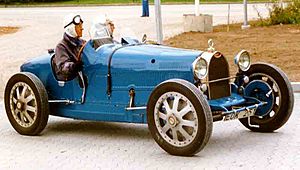
The vintage era lasted from the end of World War I (1918) until the Wall Street Crash of 1929 (1929). During this time, cars with the engine in the front became standard. Closed car bodies and standard controls were common. In 1919, most cars were open-top. By 1929, 90 percent of cars sold were closed.
Internal combustion engines kept getting better. Engines with multiple valves and overhead camshafts were made for high-end cars. Even V8, V12, and V16 engines were designed for very rich people. In 1919, hydraulic brakes were invented by Malcolm Loughead. Duesenberg used them on their 1921 Model A. In 1924, Hermann Rieseler invented the first automatic transmission, but it wasn't produced until 1940. Near the end of this era, tempered glass (now used in side windows) was invented in France.
Many car companies disappeared in the 1920s. Between 1922 and 1925, the number of US car makers dropped from 175 to 70. This was partly because companies couldn't keep up with falling prices due to assembly line production. New paints, eight-cylinder engines, four-wheel brakes, and balloon tires were big trends in 1925.
Examples of cars from this period:
- 1922–1939 Austin 7—a car that many others copied, like BMW and Nissan.
- 1922–1931 Lancia Lambda—an advanced car with a strong body and independent front suspension.
- 1924–1929 Bugatti Type 35—one of the most successful racing cars.
- 1927–1931 Ford Model A (1927–1931)—Ford's new model after the Model T. Over four million were made.
- 1930 Cadillac V-16—a very luxurious car with a V16 engine.
The Pre-War Era

This part of the classic car era started with the Great Depression in 1930 and ended after World War II, around 1946. During this time, cars with integrated fenders (wheel covers) and fully closed bodies became very popular. New sedan (or saloon) cars even had a trunk at the back for storage. Older open-top cars were mostly phased out.
By the 1930s, most of the basic car technology we use today had been invented. For example, front-wheel drive was brought back by André Citroën with the Traction Avant in 1934. However, cars with front-wheel drive were made years earlier. Also, independent suspension was first developed in 1873 but wasn't widely used until the 1930s. In 1930, the number of car makers dropped a lot. This was due to the industry becoming more organized and the effects of the Great Depression.
Examples of pre-war cars:
- 1932–1939 Alvis Speed 20—the first car with an all-synchromesh gearbox (for smoother gear changes).
- 1932–1948 Ford V-8 (Model B)—introduced the flathead V8 engine to many cars.
- 1934–1938 Tatra 77—the first car made in a series with a very aerodynamic design.
- 1934–1940 Bugatti Type 57—a fancy car for the wealthy.
- 1934–1956 Citroën Traction Avant—the first mass-produced front-wheel drive car.
- 1936–1955 MG T series—popular sports cars.
- 1938–2003 Volkswagen Beetle—a design made for over 60 years, with over 20 million cars built.
- 1936–1939 Rolls-Royce Phantom III—a luxury car with a V12 engine.
The Postwar Era

After World War II, car design changed a lot. The "pontoon" style became popular. This meant the running boards were removed, and the fenders (wheel covers) were built into the car's body. Early examples include the Soviet GAZ-M20 Pobeda (1946) and the British Standard Vanguard (1947).
Car design and production moved away from military needs in 1949. That year, General Motors's Oldsmobile and Cadillac brands introduced new V8 engines and modern car bodies. The 1951 Ford Consul joined the 1948 Morris Minor and 1949 Rover P4 in the UK car market. In Italy, Enzo Ferrari started his 250 series, and Lancia introduced the amazing V6-powered Lancia Aurelia.
Throughout the 1950s, car engines became more powerful, and cars went faster. Designs became smoother and more artistic. Cars were sold all over the world. Small cars like Alec Issigonis's Mini and Fiat's 500 became popular in Europe. In Japan, the similar kei car class grew. The Volkswagen Beetle continued to be made after the war and was exported to many countries, including the US. Meanwhile, American cars from "Big Three" (GM, Ford, Chrysler) grew larger and more luxurious.
The car market changed in the 1960s. US carmakers faced competition from imported cars. European companies used advanced technologies, and Japan became a major car-producing nation. Japanese companies started selling popular cars like the Toyota Corolla and Nissan Sunny around the world. American Motors' small Rambler cars made GM and Ford introduce their own smaller cars in 1960. Powerful engines became a big selling point for US carmakers, leading to the "muscle car" era. In 1964, the Ford Mustang created a new type of car called the "pony car." Other companies made cars to compete with the Mustang, like the Chevrolet Camaro.
Companies started to combine. For example, the British Motor Corporation brought together many brands. Their space-saving Mini, first made in 1959, was sold under different names until Mini became its own brand. Competition grew, and some older carmakers like Studebaker closed down. This trend of combining companies also happened in Italy, where bigger companies bought smaller luxury car makers like Maserati and Ferrari.
New technologies included more use of independent suspensions and fuel injection. Car safety also became more important. Inventions in the 1960s included the Wankel engine and the turbocharger. Only the turbocharger became widely used.
The 1970s were tough for carmakers. The 1973 oil crisis meant higher gasoline prices. Rules for automobile emissions control and safety became stricter. Japanese and European cars were exported more, and the economy was slow in many countries. Smaller cars became more popular. In the US, very small cars like the AMC Gremlin and Ford Pinto were introduced. Station wagons were popular, and sales of all-wheel drive off-road vehicles grew.
By the end of the 20th century, the US "Big Three" lost some of their leading position. Japan became a leader in car production. Cars also started to be made in new countries in Asia and Eastern Europe.
Examples of postwar cars:
- 1946–1958 GAZ-M20 Pobeda—a Soviet car with a smooth, "pontoon" design.
- 1947–1958 Standard Vanguard—a British mass-market car with a full pontoon design.
- 1948–1971 Morris Minor—an early postwar car sold worldwide.
- 1953–1971 Chevrolet Bel Air—known for its tailfin design.
- 1955–1976 Citroën DS—had a very aerodynamic design and new technology. It was ranked third as the Car of the Century.
- 1959–2000 Mini—a small, innovative car made for four decades. It was ranked second as the Car of the Century.
- 1961–1975 Jaguar E-Type—a classic sports car design.
- 1963–1989 Porsche 911—a sports car ranked fifth as the Car of the Century.
- 1964–present Ford Mustang—the pony car that became one of the bestselling cars of its time.
- 1966–end of the 20th century Fiat 124—an Italian car made in many other countries.
- 1967 NSU Ro 80—its wedge shape was copied later, but its Wankel engine was not.
- 1977–present Lada Niva—the first mass-produced car with full-time all-wheel drive.
The Modern Era
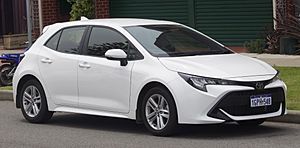
The modern era is usually the last 40 years. It's a time of more standardization and platform sharing (using the same basic parts for different car models). This helps reduce costs and development time. Cars also use more electronics for engine control and entertainment.
Today, many cars have front-wheel drive or all-wheel drive. Diesel engines are common, and fuel injection is everywhere. Most modern passenger cars have a single body structure (monocoque or unibody) with the engine placed sideways in the front.
Car body styles have also changed. Today, hatchbacks, sedans, and sport utility vehicles (SUVs) are the most popular. These cars started out practical but have become powerful and luxurious. The rise of pickup trucks in the US and SUVs worldwide has changed driving. These "trucks" now make up more than half of the world's car market. Also, the MPV class (smaller passenger minivans) was introduced, like the French Renault Espace and the Chrysler minivan in the US.
The modern era has also seen big improvements in fuel efficiency and engine power. Concerns about car emissions have been reduced with computer-controlled engine management systems.
The financial crisis of 2007–2008 greatly reduced car sales for many companies. Since 2009, China has become the world's largest car manufacturer. Car production has grown in Asia and other countries. Also, large international car groups have formed. They make cars that share the same basic parts but are sold under different brand names for different markets.
Since the late 1900s, many car awards have become well-known. These include European Car of the Year and World Car of the Year.
Examples of modern cars:
- 1966–1992 Oldsmobile Toronado—the first modern American car with front-wheel drive. It also had early electronic antilock brakes and airbags.
- 1972–present Mercedes-Benz S-Class—known for safety features like seat belt pretensioners and electronic traction control system.
- 1975–present BMW 3 Series—a car that has been on Car and Driver magazine's "Ten Best" list many times.
- 1977–present Honda Accord sedan—a popular Japanese sedan in the US.
- 1983–present Chrysler minivans—this two-box minivan design almost replaced the station wagon.
- 1984–present Renault Espace—the first mass-produced passenger minivan.
- 1986–2019 Ford Taurus—a midsized front-wheel drive sedan that was very popular in the US in the late 1980s.
- 1997–present Toyota Prius—launched in Japan and became a popular hybrid electric vehicle.
- 1998–present Ford Focus—a popular hatchback and Ford's bestselling "world car."
- 2008–2012 Tesla Roadster—the first highway-ready all-electric car made in a series for sale in the US.
- 2009–present, Mitsubishi i-MiEV—the first highway-ready all-electric car made in a series.
- 2010–present, Nissan Leaf and Chevrolet Volt—these are top-selling mass-produced electric and plugin hybrid cars. The Nissan Leaf became the bestselling highway-ready electric car in history by 2018.
- 2012–present, Tesla Model S—a plugin electric car that was the world's bestselling plugin electric vehicle in 2015.
Images for kids
Related pages
See also
 In Spanish: Historia de la automoción para niños
In Spanish: Historia de la automoción para niños


